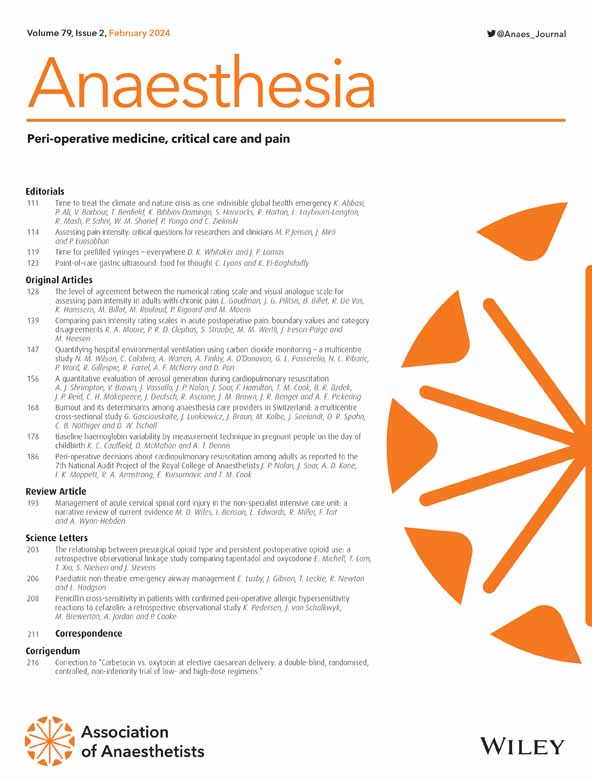Hypnosis for anaesthetists: a systematic review and meta‐analyses
IF 6.9
1区 医学
Q1 ANESTHESIOLOGY
引用次数: 0
Abstract
SummaryIntroductionTherapeutic hypnosis appears to offer psychological and physiological benefits in various medical fields, but despite increasing interest, its value for anaesthesia remains inconclusive.MethodsWe searched for studies of any design in which hypnosis was used for any intervention requiring the presence of an anaesthetist, alone or in combination with any type of anaesthesia, on children and adults. Meta‐analyses using random‐effects models were stratified on hypnosis timing, when three or more randomised controlled trials reported on a similar outcome. Additional analyses were performed adding data derived from non‐randomised controlled studies. The primary outcome was the use of hypnotics and opioids during the intervention. Secondary outcomes included all outcomes related to pain, anxiety or adverse events.ResultsWe identified 142 studies that included 9238 patients (8319 adults, 919 children). Pre‐intervention hypnosis decreased post‐intervention visual analogue scale pain score (mean difference ‐0.88 cm, 95%CI ‐1.72 to ‐0.05) and anxiety (standardised mean difference ‐0.76, 95%CI ‐1.14 to ‐0.38). Per‐intervention hypnosis decreased visual analogue scale pain intensity during the intervention (mean difference ‐1.14 cm, 95%CI ‐1.86 to ‐0.41) without impacting on post‐intervention pain; decreased post‐intervention anxiety (standardised mean difference ‐0.44, 95%CI ‐0.75 to ‐0.13); and lowered the risk of postoperative nausea and vomiting (risk ratio 0.43, 95%CI 0.25–0.74). Adding non‐randomised controlled studies did not alter these results substantially. Evidence of the impact of pre‐ or per‐intervention hypnosis on other outcomes, or of post‐intervention hypnosis on any outcome, was lacking.DiscussionHypnosis may help reduce anxiety, alleviate pain during and after a procedure and lower the incidence of postoperative nausea and vomiting. However, despite the inclusion of more than 9000 patients in studies examining the use of hypnosis for anaesthesia, its impact on most outcomes remains unknown.麻醉师的催眠:一项系统回顾和荟萃分析
治疗性催眠似乎在各个医学领域提供心理和生理上的益处,但尽管越来越多的兴趣,其麻醉价值仍不确定。方法:我们检索了所有将催眠用于任何需要麻醉师在场的干预的研究,单独或联合使用任何类型的麻醉,适用于儿童和成人。当三个或更多的随机对照试验报告相似的结果时,使用随机效应模型对催眠时间进行Meta分析。对来自非随机对照研究的数据进行附加分析。主要结果是干预期间催眠药和阿片类药物的使用。次要结局包括所有与疼痛、焦虑或不良事件相关的结局。结果纳入142项研究,纳入9238例患者(成人8319例,儿童919例)。干预前催眠降低了干预后视觉模拟量表疼痛评分(平均差值- 0.88 cm, 95%CI - 1.72 - 0.05)和焦虑(标准化平均差值- 0.76,95%CI - 1.14 - 0.38)。每次干预催眠降低了干预期间视觉模拟量表的疼痛强度(平均差异- 1.14 cm, 95%CI - 1.86 - 0.41),但对干预后疼痛没有影响;干预后焦虑减少(标准化平均差异- 0.44,95%CI - 0.75至- 0.13);降低术后恶心和呕吐的风险(风险比0.43,95%CI 0.25-0.74)。加入非随机对照研究并没有显著改变这些结果。缺乏证据表明干预前或干预后催眠对其他结果的影响,或干预后催眠对任何结果的影响。催眠可以帮助减轻焦虑,减轻手术中和手术后的疼痛,降低术后恶心和呕吐的发生率。然而,尽管有9000多名患者参与了使用催眠术进行麻醉的研究,但催眠术对大多数结果的影响仍然未知。
本文章由计算机程序翻译,如有差异,请以英文原文为准。
求助全文
约1分钟内获得全文
求助全文
来源期刊

Anaesthesia
医学-麻醉学
CiteScore
21.20
自引率
9.30%
发文量
300
审稿时长
6 months
期刊介绍:
The official journal of the Association of Anaesthetists is Anaesthesia. It is a comprehensive international publication that covers a wide range of topics. The journal focuses on general and regional anaesthesia, as well as intensive care and pain therapy. It includes original articles that have undergone peer review, covering all aspects of these fields, including research on equipment.
 求助内容:
求助内容: 应助结果提醒方式:
应助结果提醒方式:


